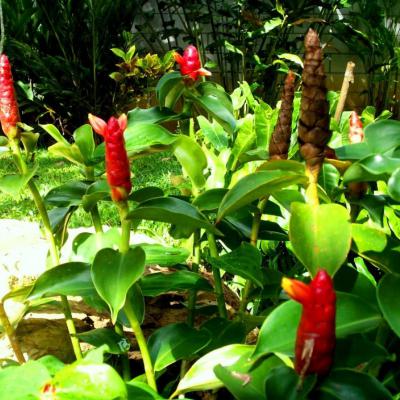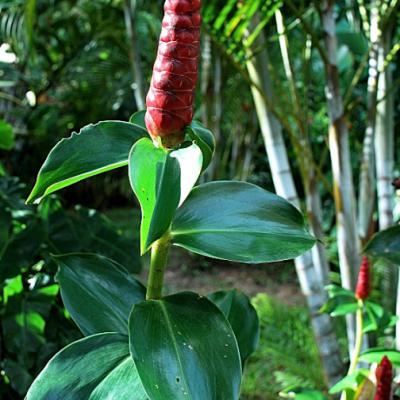Costaceae-Costus-woodsonii
Classification
- Botanical Family : Costaceae
- Genus : Costus
- Epithet : woodsonii
- German Family Name: Costus
- English Name: Red button Ginger , Dwarf French Kiss, Scarlet Spiral Flag
- Thai Name: เอื้องหมายนาดอกแดง
- Thai Phonetic: ueang maai naa dog däng
- Author: Maas
Water Requirements
Plant Type
Light Requirements
Cultivation
Costus woodsonii is a perennial, herbaceous plant native in Central America.
Very striking are the bright red bracts of the candle-like inflorescences, which are a nice contrast to the dark green foliage of the plant. The stems are lush and green. They grow up to about 120 cm.
The rather small flowers, which do not open wide, are yellow to orange and bloom from the bracts. The inflorescences are very durable.
The plant is very easy to maintain. The soil should be kept moist, overwatering should be avoided. Partial shade and also a sunny location is ideal. Occasionally the dead shoots needs to cut out.
Costus woodsonii looks best planted in large groups, and is therefore a good colorful spacefiller. The showy plants conjure a tropical feeling to any garden. In containers they do very well. The beautiful inflorescences are also perfect for the vase or for flower arrangements, where they are long lasting.
Propagation: by dividing the clumbs, by cuttings (Costaceae ginger are the only one that can be propagated by cuttings) or by separation of the newly formed shoots on older stems or by seeds or from pieces of the rhizomes.
Cheilocostus speciosus spreads by itself, in which from the rhizome (thick fleshy root) develop new shoots and the plant spreads in all directions.
Costus woodsonii ist eine ausdauernd, krautige Pflanze mit Ursprung in Mittelamerika.
Sehr auffällig an Costus woodsonii sind die leuchtend roten Hochblätter (Brakteen) der kerzenförmigen Blütenstände, die ein schöner Kontrast zu dem dunkel grünen Laub der Pflanze sind. Die Stängel sind saftig und grün. Sie werden bis ca. 120 cm hoch.
Die eher kleinen Blüten, die sich nicht weit öffnen, sind gelb bis orange und erblühen nacheinander aus den Hochblättern. Die Blütenstände sind sehr langlebig.
Die Pflanze ist pflegeleicht. Der Boden sollte feucht gehalten, Staunässe jedoch vermieden werden. Halbschatten und auch ein sonniger Standort sind ideal. Gelegentlich sollten die abgestorbenen Triebe zurück geschnitten werden.
Costus woodsonii sieht am besten in größeren Gruppen angepflanzt aus und eignet sich daher sehr gut, wenn ein Platz mit Farbe gefüllt werden soll. Die auffälligen Pflanzen zaubern ein tropisches Flair in jeden Garten. Auch in Kübeln gedeihen sie ausgezeichnet. Die schönen Blütenstände eignen sich hervorragend für die Vase oder Blumengestecke, wo sie lange haltbar sind.
Vermehrung: durch Teilung der Pflanzenballen, durch Stecklinge (Costaceae sind die einzigen Ingwer, die durch Stecklinge vermehrt werden können) oder durch Abtrennung der neugebildeten Triebe an älteren Stämmen oder durch Samen oder durch Verpflanzung von Stücken der Wurzel.
Costus woodsonii verbreitet sich von selbst, in dem sich aus dem Rhizom (dicke fleischige Wurzel, die als Überdauerungsorgan dient) sich die neuen Triebe bilden und sich die Pflanze so in alle Richtungen ausbreitet.


